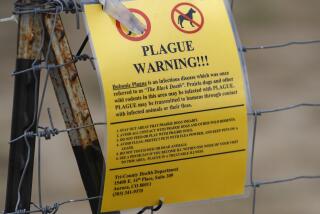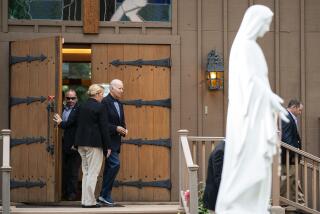Resort Town Recovers Slowly From a Devastating Outbreak of Wellness : History: When antibiotics replaced fresh air as the treatment for TB, a village famous for its hospitality and healthful climate fell on hard times.
SARANAC LAKE, N. Y. — This was a typical one-industry town--with a difference. Its economic base was illness.
For nearly 70 years, Saranac Lake was synonymous with both a feared disease, tuberculosis, and the sanitarium “cure” that was medicine’s best effort at treating it.
The TB sufferers have been gone for a generation, but Saranac Lake is still proud to be known as the “City of the Sick.”
Salvation came to TB patients in the early 1950s, when antibiotics conquered the disease. The good news dealt an economic blow to this remote village in the Adirondack Mountains, about 270 miles north of New York City.
“It was a disaster for the community,” said Barbara Parnass of the Historic Saranac Lake preservation group. “It wasn’t the kind of thing that was dramatic, like a fire, but the slow ebbing of the curing industry affected the community very severely.”
In the heyday of the cure, spitting on a Saranac Lake sidewalks could get you a summons from the police because the sputum might contain the dreaded TB bacterium. It was a place where radios were silent each afternoon so that TB patients could rest quietly in the open air on their cure porches.
“In some ways, the village had been run by the doctors and the lawyers and the bankers,” Parnass said. “They sat on the board of health. They made the rules and regulations. There was a very precise booklet printed up, telling everyone how to behave. When the curing collapsed, the doctors retired or they found other places to practice. That left an awful lot of the service industry here with nobody to serve.”
Only in recent years has Saranac Lake shown signs of snapping out of it. The Tudor-style Will Rogers Hospital, which once cared for show business tuberculars, has been converted to condominiums.
The Trudeau Sanitarium, now a conference center, belongs to the American Management Assn. The Ray Brook Sanitarium building nearby is a state prison.
Many of the 300 cure cottages, the mini-hospitals that made Saranac Lake unique among TB centers, are being restored by private owners to their turn-of-the-century grandeur.
Parnass says that the sudden collapse of the curing industry was helpful to historical preservation efforts.
“When the plug was pulled, the economic bottom dropped out of the whole village,” she said. “The railroad stopped running. There was no money to tear down and put up new houses. In some ways it was good, because it held the housing stock where it was.”
Nine out of 10 structures in Saranac Lake, which has about 5,500 residents today, were built before World War II. Parnass’ group recently applied to have 187 buildings in the village, including 63 of the cottages, named to the National Register of Historic Places.
The village remembers its legacy in other ways, too.
A sign proclaiming Saranac Lake “America’s Pioneer Health Resort” remains. In September, Parnass’ group will sponsor a second reunion of former patients and their relatives with doctors, nurses and others who cared for them here. About 200 people attended the first reunion in 1987.
They are among the dwindling number of people who remember firsthand the misery and terror generated by tuberculosis.
The “white plague” stalked slums and wealthy neighborhoods with equal impunity. Keats, Thoreau and Kafka were just a few of the leading lights of their ages who died of TB, popularly called “consumption” because of the way the disease seemed to consume the tattered lungs of those stricken with its most common form, pulmonary tuberculosis.
What made tuberculosis seem even more terrible was that, for a long time, no one was sure what caused it. A German physician, Dr. Robert Koch, isolated the TB bacterium in 1882, but it took researchers another 70 years to find the right antibiotics to attack the infection.
Dr. Lee Reichman, speaking for the American Lung Assn., compared the fear of TB, at its height in the late 19th Century and early 20th Century, to the fear of AIDS, or acquired immune deficiency syndrome, today.
In their quest for an effective TB treatment, American doctors began to recommend that patients live in dry climates or at high elevations, such as in the Rockies or the Adirondacks. It was thought that such an atmosphere would dry out the clogged lungs of TB patients and retard the disease.
Dr. Edward Livingston Trudeau, a tubercular who believed that being in the Adirondacks saved his life, was credited with popularizing the region as a health resort.
In 1884, Trudeau established the first U.S. sanitarium for TB patients in Saranac Lake. Modeled on German sanitariums of the era, Trudeau used the tiny, two-bed cottage later nicknamed “Little Red” to develop a model for treatment that was eventually adopted by most American sanitariums.
The main activity at a “san” was inactivity.
Patients were exposed to fresh air, during the harshest days of winter as well as in sweltering summer heat, by sitting quietly for hours at a time on specially designed lounging chairs. Those too ill to sit or stand were wheeled onto the porches in their beds. Body temperature and weight were monitored carefully, and great emphasis was placed on proper diet.
Saranac Lake took pains to be a happy place, to make the tuberculars welcome and to ease their burden. There were picnics, sleigh rides, hayrides and bedside instruction in activities from bookbinding to bird watching.
A winter carnival begun in 1897 as a diversion for TB patients is now billed by village fathers as the oldest of its kind in the United States.
More to Read
Sign up for Essential California
The most important California stories and recommendations in your inbox every morning.
You may occasionally receive promotional content from the Los Angeles Times.










